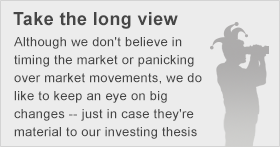
Well-received earnings from Citigroup and more merger-and-acquisition news from the health-care sector helped to buoy sentiment on Monday, as the S&P 500 gained 0.5% to put it within a half-percent of its record high from the beginning of the month. The narrower Dow Jones Industrial Average (^DJI +0.16%) rose 0.7%, while the technology-heavy Nasdaq Composite Index (^IXIC +0.57%) was up 0.6%.
The "one-way" stock market coupled with ultra-low asset market volatility is raising the specter of overvaluation -- which might be behind gold's resurrection this year. Since the beginning of July, the SPDR Gold Shares (GLD +1.32%), the most popular gold-backed ETF, has added over $400 million in assets under management. Following last year's brutal bear market in gold, are we now witnessing the beginning of a recovery?

Source: Wikimedia Commons.
Stocks' gravity-defying rally has garnered a lot of attention, so you may not have noticed gold outperforming stocks during the first half of the year, notching up a 9.2% return (against a 6.1% rise in the S&P 500; even once you include dividends, stocks lagged gold). According to data from the Commodity Futures Trading Commission, investors' net long position in gold increased 5.4% in the week to July 8 to 144,272 futures and option contacts -- the largest such position since November 2012. Gold has now put together the longest series of weekly price gains in three years.
That data isn't enough to convince Goldman Sachs' head of commodities research, who told Bloomberg last Friday:
Some people are moving into inflationary hedge assets. Gold will start moving lower once there is more confidence in the recovery, without significant inflationary concerns. ... [Prices will] likely end lower this year.
Jeffrey Currie is maintaining his $1,050-per-ounce price target for the end of 2014 -- a forecast he made at the start of the year. Last year -- whether through prescience or straight luck -- he managed to issue a sell recommendation two days before a two-day 13% drop, which ultimately gave way to the yellow metal's largest price decline in three decades.
Goldman's view stands in sharp contrast to that of John Hathaway, the manager of the Tocqueville Gold Fund, who wrote in his most recent quarterly letter that "the precious metals complex, both mining shares and bullion, appears to be in the process of completing a major bottom extending back to mid-2013."
Unfortunately, Hathaway loses credibility when he goes on to write that he views "the upside potential to be as attractive as in 1999, before the 7.5x advance in the USD bullion price in the ensuing 12 years commenced." A 7.5-times advance from current prices would put gold at roughly $10,000 per ounce; the odds of having that occur, even over a 12-year timeframe, look pretty remote, particularly so shortly after the previous advance.
Hathaway has more interesting things to say about other asset classes (including stocks), the prices of which have been inflated by the Federal Reserve's extraordinary set of policies, including quantitative easing and zero interest rates:
Extreme high valuations of financial assets are supported by DCF models based on ultra-low interest rates. Higher interest rates will (1) undermine fundamentals, making record debt levels more problematic, and (2) deflate valuations of the anticipated future cash flow generated by equities, junk bonds, and sovereign debt.
What he fails to mention, however, is that higher interest rates are also detrimental to the price of gold -- unless you assume a significant acceleration in inflation. As there is no yield on gold, it becomes relatively less attractive as interest rates rise, all other things being equal. That's one of the reasons I join Currie in his bearish stance on gold: We are getting ever closer to the moment when the Federal Reserve will begin raising interest rates, whether that moment is at the middle or the end of next year -- or later. The turn in the rate cycle will be a major headwind for gold.
Of course, all other things are not always equal. For example, if the Fed's exit from its policies is mishandled and there is a dislocation in other asset markets, gold could benefit. Nevertheless, even after last year's bear market, gold remains significantly above its inflation-adjusted average historical price; on that basis alone, the most likely long-term scenario for gold remains bearish. In the short term, it's anyone's guess -- and Goldman's is as good as any other.







